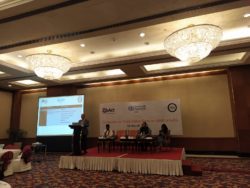“Nothing about us without us”
Community engagement the way forward to identify local problems and provide community-led sustainable solutions to antimicrobial resistance
In March 2022, ReAct Asia Pacific, World Animal Protection India, and the World Health Organisation (WHO) Country Office organised a Colloquium on State Action Plans on AMR in India. This meeting discussed the challenges and opportunities, at state level, related to drafting and implementing State Action Plans for Containment of Antimicrobial Resistance (SAPCAR).
One of the sessions; Behaviour Change and Local Action Plans on AMR, was moderated by our collaborator Professor Rajib Dasgupta who worked with CE4AMR on our Challenge Cluster project: CE4AMR the One Health Approach. Professor Dasgupta is based at the Centre of Social Medicine and Community Health, Jawaharlal Nehru University, New Delhi, but wore several ‘hats’ to this event by representing the CE4AMR Network and One Health Poultry Hub.

Attendees at the Colloquium on State Action Plans on AMR in India, March 2022
In this blog Pallavi Mishra from Jawaharlal Nehru University, and the One Health Poultry Hub describes the topics and outcomes of this discussion panel.
The Behaviour Change and Local Action Plans on AMR session focused on AMR interventions at the grassroots level which chimes very much with the ethos of CE4AMR and it’s associated projects. The panel had broad representation from diverse stakeholders. It began with presentations from United Nations Environment Programme, Consumer Unity & Trust Society, MSF Access Campaign, Government of Kerela, and a public engagement initiative- Superheroes Against Superbugs.
Panellists discussed the need for a top-down and bottom-up approach to identify solutions to AMR at the local level and learning from examples of the community-led initiatives so that they could be replicated in other parts of the country. It was an important session for all attendees to discuss the various initiatives that have taken place at local level and to understand the challenges and opportunities from the experiences of panellists working closely with the community.

Professor Dasgupta chairing the Behaviour Change and Local Action Plans on AMR session
Rights of the marginalised was an issue raised by a panellist who works closely with multiple stakeholders on various diseases. In her experience, the most marginalised communities have been campaigning for health issues and encouraging governments to implement policies. She urged that diagnostics for AMR need to be strengthened, and the system needs to be patient-centric. It was emphasised that communities who are impacted by AMR should be made a part of these discussions. However. their roles and rights need to be acknowledged and guaranteed while discussing these issues and designing interventions. The way forward would be to include civil society organisations to monitor the drafting and implementation of state action plans. Space should be created for the community stakeholders so that they could help the state negotiate for better resource allocation from the centre.
Raising awareness among users, including individuals, farmers, and veterinarians, was highlighted by another panelist. The farming systems in low and middle-income countries (LMICs) are quite different from those of high-income countries (HICs): in LMICs, it is the production by the masses, but in HICs, it is mass production. Due to a greater involvement of people in farming in LMICs, the scale of AMR ought to be higher than HICs due to the expanses of production. Farmers want to maximise profits and therefore use antibiotics in fertilisers and growth promoters. Engaging with Agriculture Extension Wings can help in making livestock farmers aware of the best practices and reducing AMR. Currently, there is a lack of mass awareness programmes and multisector approaches to addressing AMR in India.
Simplifying the language used to communicate about AMR is a key challenge. The panelists were of the view that the language should not be loaded with biomedical and scientific terms, which makes it difficult for consumers at the local level to comprehend. Awareness among consumers will result in pressure for the effective implementation of the state action plans. We need to include farmers, pharmaceutical organisations, and Accredited Social Health Activists (ASHAs) at the local level in these campaigns. By working closely work with the communities, these actors are capable of influencing choices and practices at local level. There is also a need to promote organic farming culture by propagating the best examples of farmers who have switched to organic farming.
Involvement of school children in the drive against AMR is also crucial as it is not only affecting their present but future as well. The panelists suggested that we need to tailor the communication strategy according to our target audience. The messages and stories on AMR should resonate with the context and experiences of people. There is a need to discuss the human impacts of AMR; humanisation of the problem needs to be central to community engagement. Media personnel and filmmakers can play a key role by presenting these stories in a format that is understandable to people.
AMR is an abstract and invisible problem that needs to be made visible to people as well as to policymakers by highlighting examples of its adverse consequences. We need to bring real-world stories of AMR – of those affected by it and the alternative best practices. Initiatives based on citizen science can also be helpful in addressing AMR and strengthening community engagement. The community should also be involved in generating data and devising solutions rather than always being held accountable for adding to the problem of the irresponsible use of antibiotics.
The panelists agreed that we need to strengthen the regulatory system for farming and import of farm products so that best practices like organic farming could be promoted and good quality products made available to people at reasonable costs. We also need to learn from the success stories of other sectors and make efforts to replicate those strategies in containing AMR. Evidence should be generated at the local level to inform policies. They emphasised that the AMR action plan needs to be localised and decentralised.
About the author
 Dr Pallavi Mishra is a Postdoctoral Fellow at Jawaharlal Nehru University, contributing to the Social Hub research on people and poultry. Dr Mishra has worked at the Centre for Chronic Disease Control (CCDC) and the Public Health Foundation of India (PHFI). She is a qualitative researcher with experience in health systems policy research and communicable and non-communicable diseases. She holds PhD and M Phil degree in International Politics and Global Health from the Jawaharlal Nehru University.
Dr Pallavi Mishra is a Postdoctoral Fellow at Jawaharlal Nehru University, contributing to the Social Hub research on people and poultry. Dr Mishra has worked at the Centre for Chronic Disease Control (CCDC) and the Public Health Foundation of India (PHFI). She is a qualitative researcher with experience in health systems policy research and communicable and non-communicable diseases. She holds PhD and M Phil degree in International Politics and Global Health from the Jawaharlal Nehru University.
